The hardwood flooring industry is undergoing an exciting transformation in 2024, where timeless classics meet cutting-edge innovation. Homeowners and designers alike are gravitating towards flooring that not only elevates the beauty of their spaces but also aligns with the latest in sustainability and technology. This year’s trends showcase a perfect blend of traditional craftsmanship with a modern twist, opening new possibilities for both new builds and renovations.
From eco-friendly materials to smart technology integration, the hardwood flooring industry is adapting to meet the changing needs and preferences of customers. In this comprehensive guide, we’ll explore the top hardwood floor trends of 2024, providing insights into colors, textures, patterns, and technological innovations that are shaping the future of home interiors.
1. Sustainable and Eco-Friendly Options
Sustainability continues to be a driving force in the hardwood flooring industry. Consumers are increasingly conscious of their environmental footprint, leading to a surge in demand for eco-friendly flooring options. Manufacturers like mafi and Scheucher are responding with innovative solutions that combine beauty, durability, and sustainability.
- Engineered Wood Floors: Engineered hardwood floors are also seeing innovations in sustainability. Many manufacturers are now using responsibly sourced wood veneers combined with eco-friendly core materials, such as recycled wood fiber or even recycled plastic. These options offer the look of solid hardwood with enhanced stability and a reduced environmental impact.
- Reclaimed Wood Flooring: One notable trend is the rise of reclaimed wood flooring. These floors are crafted from salvaged timber, often sourced from old barns, factories, or retired ships. Each plank tells a story, bringing character and history into modern homes while reducing the demand for new timber harvesting.
- Zero Waste Natural Wood Flooring: Zero waste natural wood flooring is a sustainable choice that uses every part of the tree, ensuring no material goes to waste. It’s also carbon negative, sequestering more carbon dioxide during its growth than is emitted during its production, helping to combat climate change. This makes it an eco-friendly option for environmentally conscious consumers. We offer zero waste natural wood flooring from multiple brands, including mafi and Scheucher.
Certification programs like the Forest Stewardship Council (FSC) are becoming increasingly important to consumers. Flooring products bearing the FSC label assure buyers that the wood comes from responsibly managed forests, balancing environmental, social, and economic concerns. Check out more information on certifications for brands we carry here and here.
2. Wide Plank Floors: The Continuing Trend
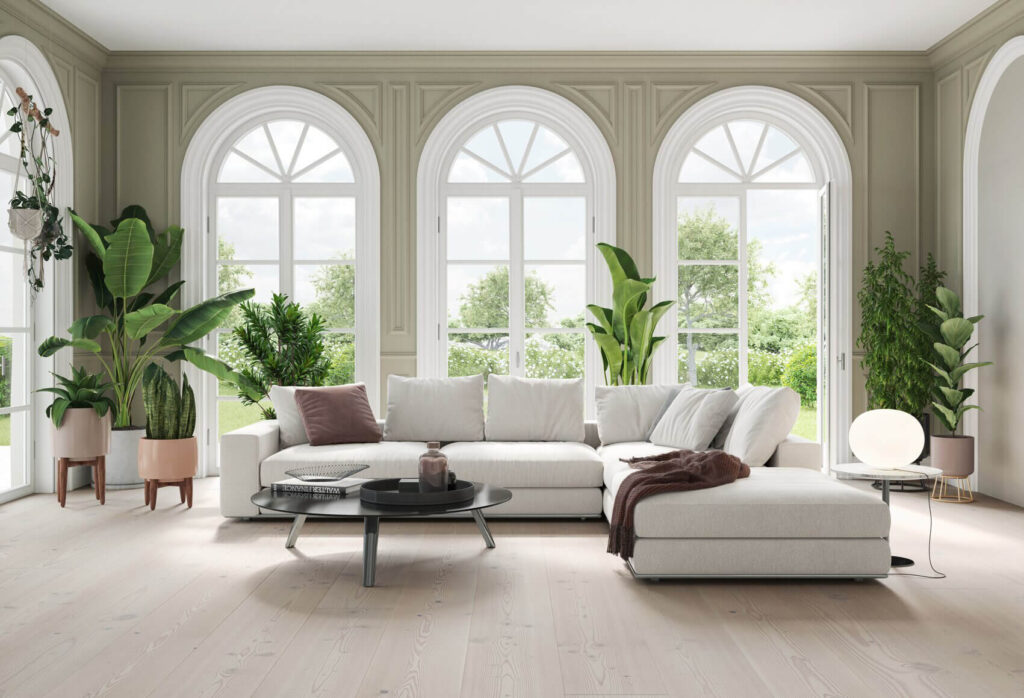
The popularity of wide plank hardwood floors shows no signs of waning in 2024. This trend, which has been gaining momentum over the past few years, continues to dominate both residential and commercial spaces. Wide planks, typically measuring 5 inches or more in width, offer a bold, contemporary look that can dramatically transform any room. In fact, our in stock wide plank floors are 7.17 inches in width.
One of the main appeals of wide plank flooring is its ability to create an illusion of more space. In smaller rooms or apartments, wider planks can make the area feel larger and more open. In larger spaces, they provide a sense of grandeur and luxury. This versatility makes wide planks a favorite among interior designers working on various projects, from cozy urban lofts to sprawling suburban homes.
We’re seeing an increase in extra-wide planks, some reaching widths of 10 inches or more. These super-wide planks create a striking visual impact and allow the natural beauty of the wood grain to take center stage. They’re particularly effective in open concept living areas, where they can unify the space and create a seamless flow from room to room.
Another trend in the wide plank category is the use of long boards. Manufacturers are producing planks in lengths up to 12 feet or more, reducing the number of seams in the floor and creating a clean, uninterrupted look. This trend is especially popular in modern and minimalist interiors, where simplicity and clean lines are prized.
While oak remains a popular choice for wide plank floors, we’re also seeing increased interest in other species like walnut and ash. These different wood species offer unique graining patterns and color variations that can add depth and character to wide plank installations.
3. Texture and Character: Rustic and Distressed Looks
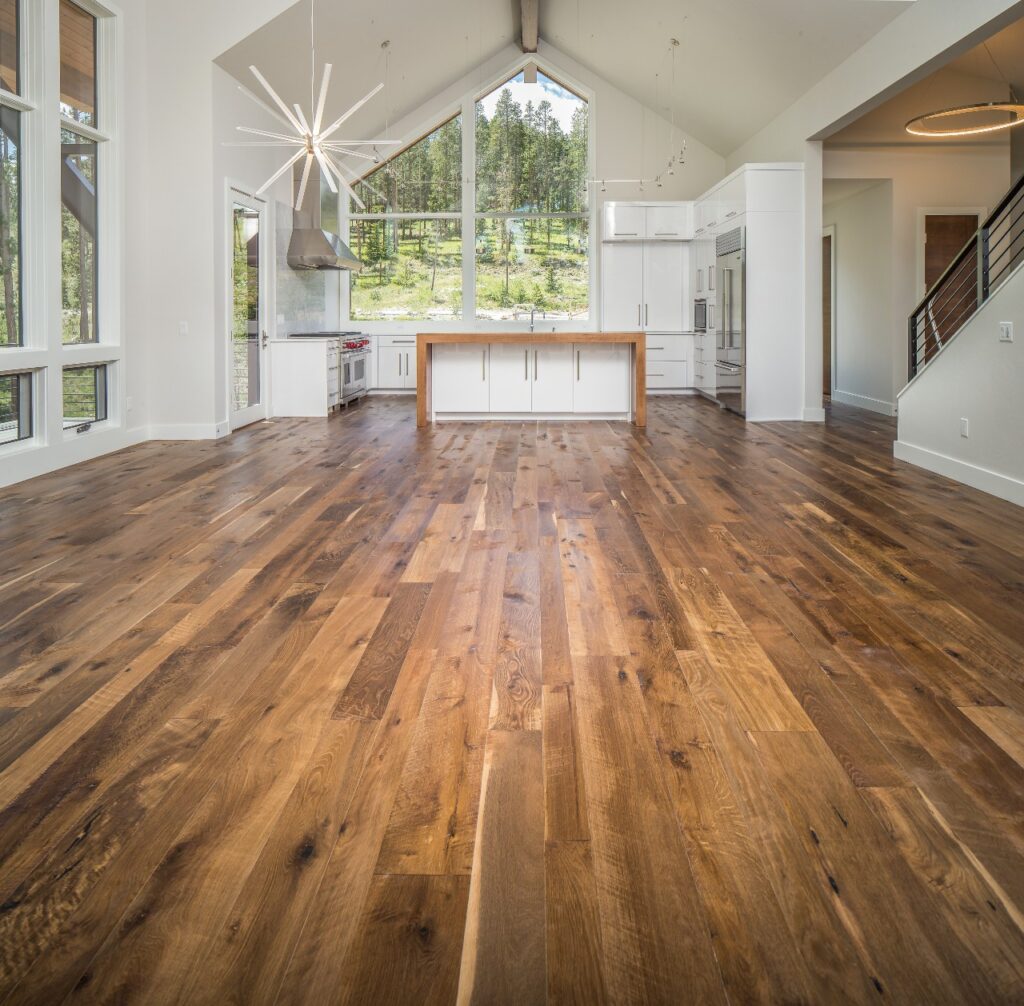
This year, there’s a growing appreciation for hardwood floors that tell a story through their texture and character. Homeowners are moving away from perfectly smooth, uniform surfaces in favor of floors that showcase the natural imperfections and unique characteristics of wood.
- Rustic and Distressed: Rustic and distressed hardwood floors are at the forefront of this trend. These floors feature intentional wear patterns, saw marks, knots, and other natural blemishes that give them an aged, lived-in appearance. This look is particularly popular in farmhouse-style homes, industrial lofts, and eclectic interiors where a touch of authenticity and warmth is desired.
- Hand-Scraped: Hand-scraped hardwood floors continue to be in demand. This technique, where each plank is individually scraped to create a time-worn look, results in a floor with deep texture and rich character. The irregularities in the surface not only add visual interest but also help to hide everyday wear and tear, making these floors practical for high-traffic areas.
- Wire-Brushed: Wire-brushed floors are another textured option gaining traction. This technique involves using wire brushes to remove the soft wood between the grain, leaving a textured surface that highlights the natural grain pattern. Wire-brushed floors offer a subtler texture compared to hand-scraped options, making them versatile enough for both traditional and contemporary interiors.
- Reclaimed: Reclaimed wood floors, mentioned earlier for their sustainability, also play into this trend. These floors often come with natural distressing from their previous life, including nail holes, insect marks, and varying color tones. Each plank is unique, creating a floor with unparalleled character and history.
It’s worth noting that while the rustic trend is strong, it’s evolved from the heavily distressed looks of previous years. We’re seeing a preference for more refined rustic styles that balance character with elegance, suitable for a wider range of interior design styles.
4. Color Trends: From Light to Dark
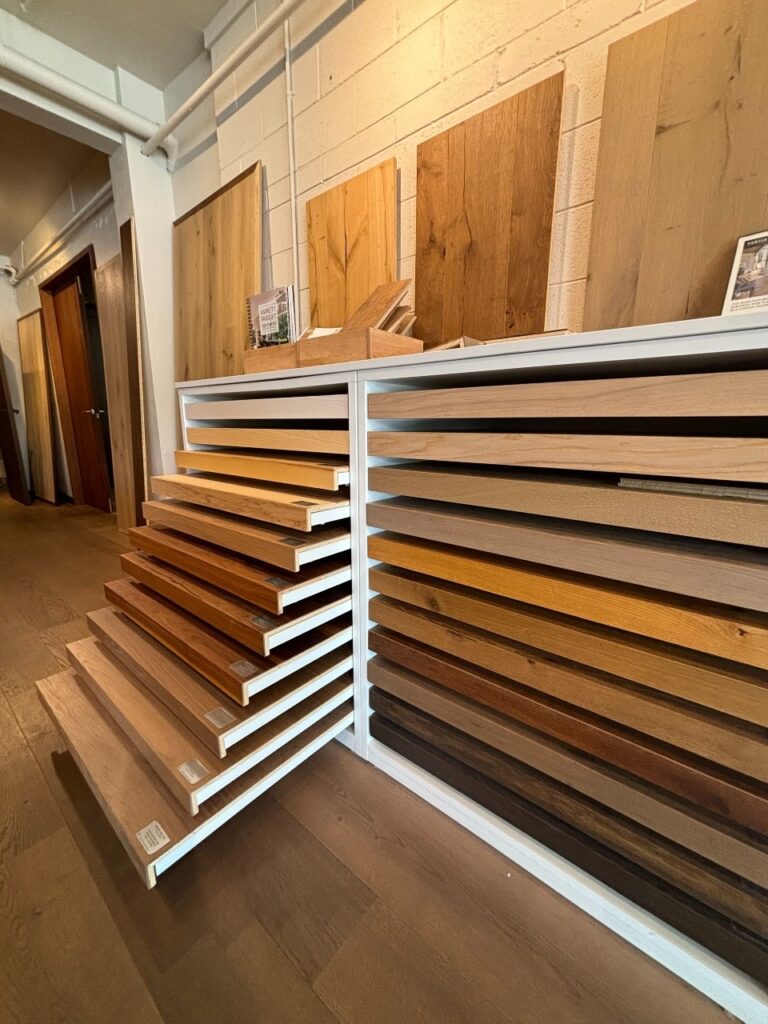
The color palette for hardwood floors is diverse, catering to a wide range of design preferences and interior styles. While certain colors are emerging as front-runners, the overall trend is towards natural, organic tones that highlight the inherent beauty of wood.
- Light and Natural Tones: Light-colored hardwood floors continue to be immensely popular. Blonde and honey-toned woods, as well as whitewashed finishes, are favored for their ability to make spaces feel larger, brighter, and more open. These lighter tones work particularly well in Scandinavian-inspired interiors and modern minimalist designs. Species like ash, maple, and white oak are often chosen for their naturally light coloration.
- Gray and Greige: The gray trend that has dominated in recent years is evolving. While cool grays are still present, we’re seeing a shift towards warmer gray tones and “greige” – a blend of gray and beige. These colors offer a neutral backdrop that complements a wide variety of design styles and color schemes. Gray-toned floors can range from light, weathered looks to deeper charcoals, providing versatility in design applications.
- Mid-Tones: Medium brown tones are making a strong comeback in 2024. These warm, inviting colors – think walnut, chestnut, and rich oak – add depth and warmth to interiors without overwhelming the space. They’re particularly well-suited to transitional and traditional home styles, offering a timeless appeal that can withstand changing design trends.
- Dark and Dramatic: On the opposite end of the spectrum, there’s growing interest in very dark, almost black hardwood floors. These dramatic floors create a striking contrast with light walls and furnishings, lending a sophisticated, luxurious feel to interiors. Ebony-stained oak and dark walnut are popular choices for achieving this bold look.
- Two-Tone and Color Variation: Another trend we’re seeing is an appreciation for natural color variation within hardwood floors. Rather than uniform color, many homeowners are opting for floors that showcase the natural differences in tone between heartwood and sapwood. This can create a two-tone effect that adds visual interest and depth to the floor.
- Colorful Stains: While not mainstream, there’s a niche trend towards colorful stains in hardwood flooring. Subtle blues, greens, and even pastel tones are being used to create unique, personalized floors. This trend is particularly popular in creative spaces and homes with eclectic design schemes.
5. Mixed-Width Planks: Adding Visual Interest
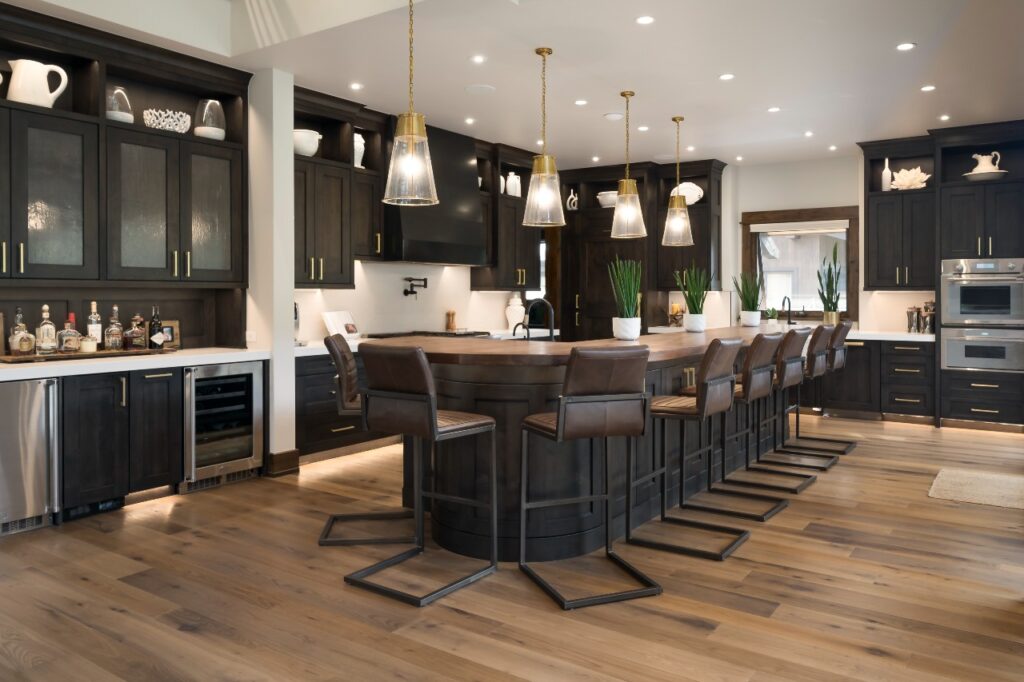
We’re seeing a rise in the popularity of mixed-width planks in hardwood flooring. This trend involves using planks of varying widths within the same installation, creating a visually dynamic and unique floor that catches the eye and adds character to any space.
Typically, a mixed-width installation might include two or three different plank widths. For example, a common combination could be 3-inch, 5-inch, and 7-inch wide planks used together. The varying widths can be laid in a repeating pattern or randomly distributed throughout the floor, depending on the desired effect.
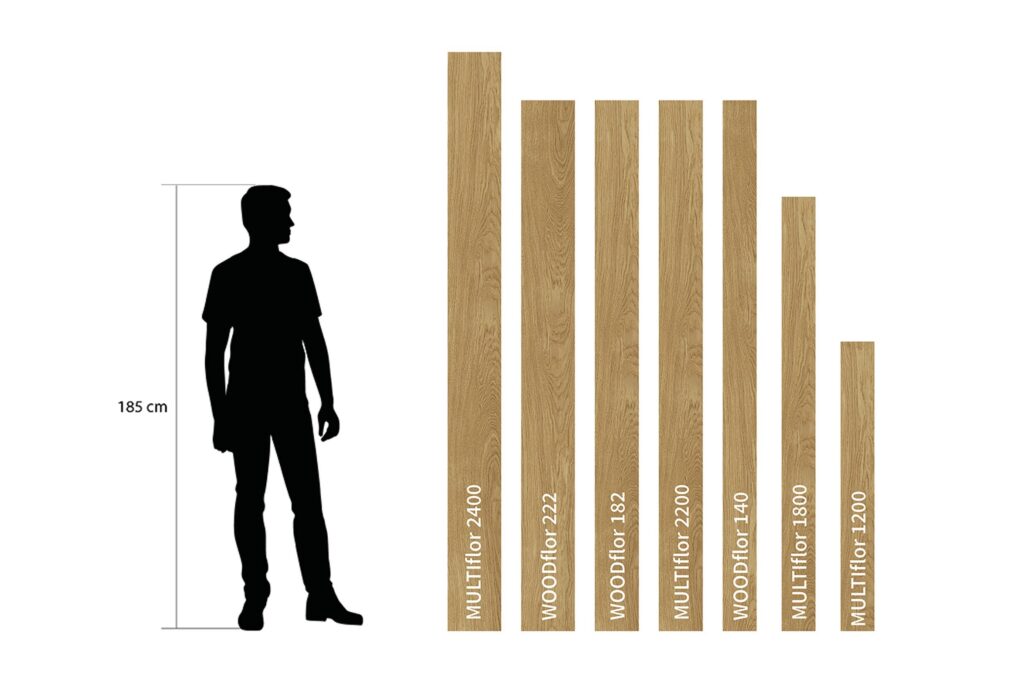
Mixed-width planks are particularly effective in larger spaces, where they can break up the monotony of a large floor area. They’re also great for creating a custom, bespoke look that sets a home apart from cookie-cutter designs.
This trend works well with various wood species and colors, from light oak to dark walnut. It’s also compatible with different textures and finishes, allowing for even more customization and creativity in floor design.
While mixed-width planks offer a unique aesthetic, they require careful installation to ensure a balanced look. As such, it’s crucial to work with experienced flooring professionals who can execute this design effectively.
6. Herringbone and Chevron Patterns: A Classic Revival
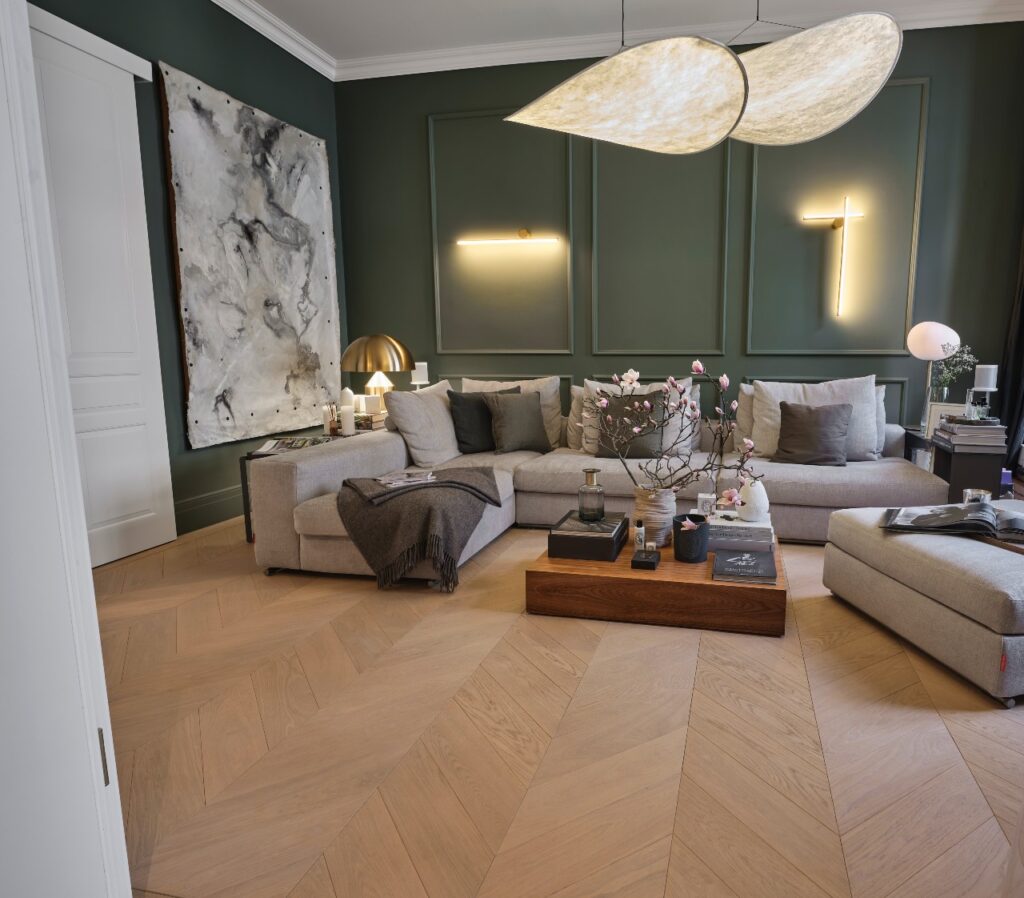
2024 is witnessing a strong resurgence of classic parquet patterns, particularly herringbone and chevron. These timeless designs are being embraced in both traditional and contemporary interiors, offering a sophisticated alternative to straight plank installations.
Herringbone Pattern
The herringbone pattern, characterized by rectangular pieces laid in a zigzag pattern, is experiencing a major comeback. This classic design, which dates to the 16th century, adds a sense of movement and elegance to any room. In 2024, we’re seeing herringbone patterns in various scales, from petite, delicate arrangements to bold, oversized versions that make a dramatic statement.
Chevron Pattern
While similar to herringbone, the chevron pattern features planks cut at a 45-degree angle to create a perfect V-shape where they meet. This creates a more pointed, arrow-like pattern compared to the broken zigzag of herringbone. Chevron floors offer a sleek, modern look that can add a touch of European sophistication to interiors.
Modern Interpretations
While these patterns are rooted in tradition, modern interpretations are giving them fresh appeal. For instance, we’re seeing chevron and herringbone patterns executed with wide planks for a contemporary twist. Some designers are experimenting with mixed wood tones within these patterns, creating striking visual effects.
Versatility in Application
One of the reasons for the popularity of these patterns is their versatility. They work well in various spaces, from entryways and living rooms to bedrooms and home offices. In larger rooms, these patterns can define separate areas without the need for physical barriers, making them ideal for open-concept living spaces.
Interestingly, the herringbone and chevron trend is often combined with other current flooring trends. For example, you might see a herringbone pattern executed in wide planks, or a chevron design featuring the warm gray tones that are popular this year. This blend of classic patterns with modern elements creates a unique, customized look.
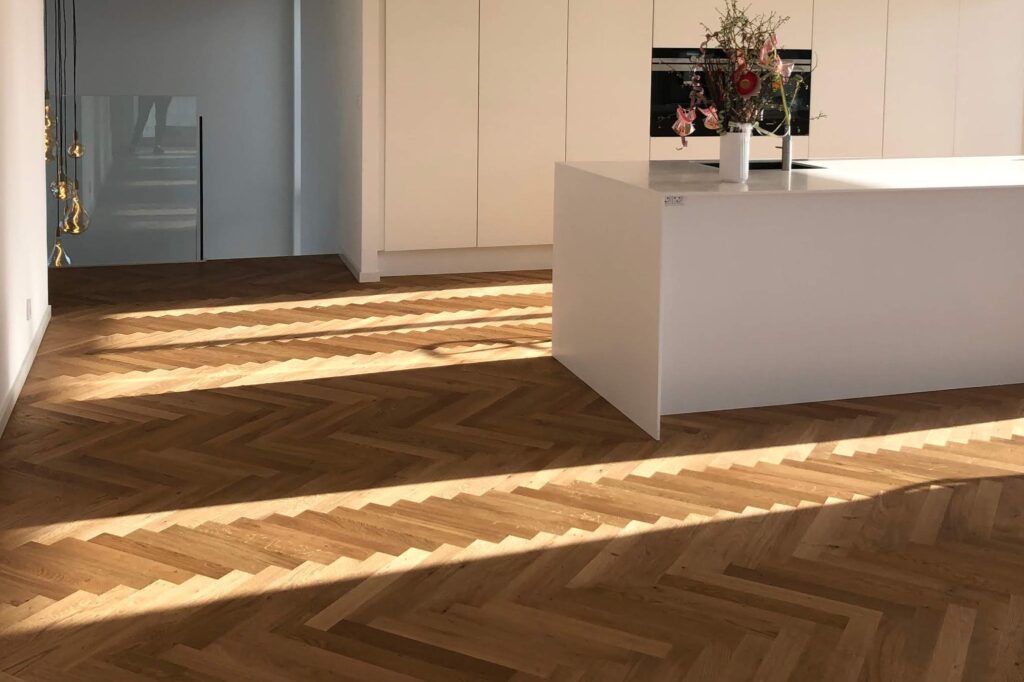
7. Innovative Finishes: Matte and Ultra-Matte
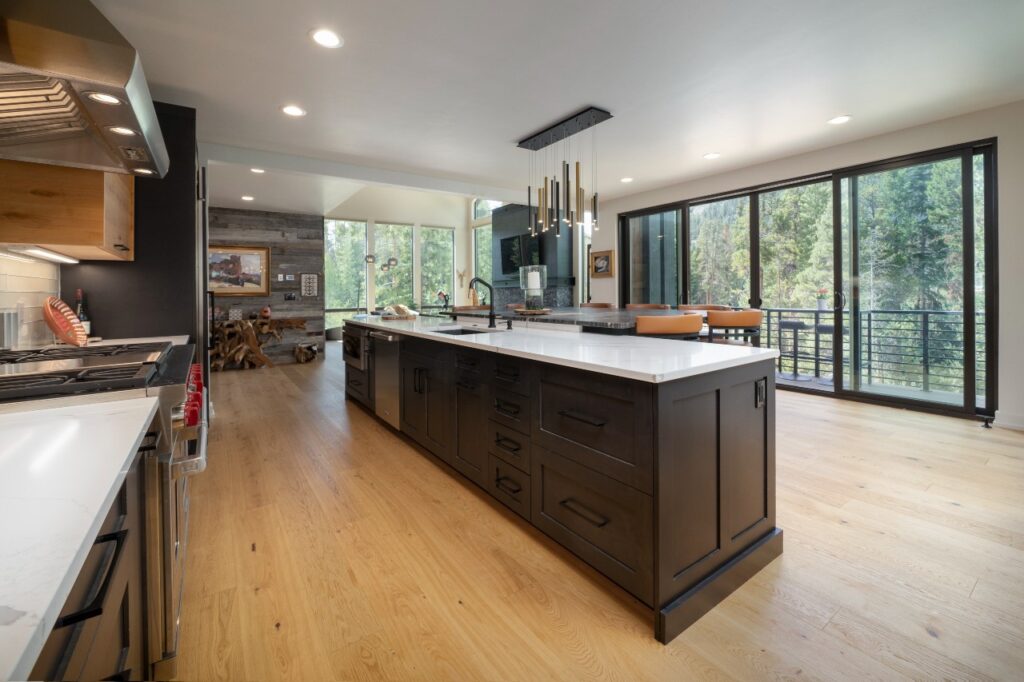
There’s a significant shift away from high-gloss finishes towards matte and ultra-matte finishes in hardwood flooring. This trend aligns with the overall movement in interior design towards more natural, understated aesthetics.
- Matte: Matte finishes offer a low-sheen, natural look that enhances the wood’s inherent beauty without the reflective quality of glossier finishes. These finishes allow the grain and color of the wood to take center stage, creating a more organic and authentic appearance. Matte floors are particularly popular in contemporary and minimalist interiors, where they contribute to a sleek, sophisticated atmosphere.
- Ultra-Matte: Taking the matte trend a step further, ultra-matte or “zero-gloss” finishes are gaining traction. These finishes create an almost raw wood look as if the floor has been left untreated. Ultra-matte floors have a velvety appearance and feel, offering a unique tactile experience underfoot. They’re especially effective in creating a cozy, intimate ambiance in bedrooms and living areas. Beyond aesthetics, matte and ultra-matte finishes offer practical benefits. They’re better at hiding small scratches, dents, and dust compared to their glossy counterparts, making them a great choice for high-traffic areas or homes with children and pets. These finishes also reduce glare, which can be particularly beneficial in spaces with lots of natural light. The Ultra-Matte finish that we use is Purotec. Learn more about this finish here.
- Oil-Based: In line with the matte trend, we’re seeing increased interest in oil-based finishes. These finishes penetrate the wood rather than sitting on top, enhancing the natural grain and providing a low-sheen, matte appearance. Oil-based finishes also offer the advantage of being easier to touch up and repair in specific areas without having to refinish the entire floor.
- Color Enhancement: Matte and ultra-matte finishes are being used to enhance the natural colors of wood or to achieve specific color effects. For instance, a matte finish on a light oak can create a beautiful, sun-bleached look, while an ultra-matte finish on walnut can deepen and enrich its natural color variations.
8. Smart Flooring Technology
The integration of technology into hardwood flooring is becoming increasingly prevalent. This emerging trend is transforming traditional hardwood floors into smart, interactive surfaces that offer both functional and aesthetic benefits.
- Embedded Sensors: One of the most exciting developments in smart flooring is the incorporation of embedded sensors. These sensors can be seamlessly integrated into hardwood planks, allowing the floor to detect and respond to various stimuli. For instance, some smart floors can track movement, potentially alerting homeowners to falls or unusual activity, which is particularly valuable for households with elderly residents or young children.
- Temperature Control: Smart hardwood flooring is being integrated with underfloor heating systems, allowing for more efficient and precise temperature control. Some systems can be programmed to adjust temperatures in different areas of the home based on usage patterns or personal preferences, contributing to both comfort and energy efficiency.
- Lighting Integration: Another exciting trend is the integration of LED lighting within hardwood flooring. These systems can be programmed to create subtle lighting effects, serve as nighttime guide lights, or even display information. For example, smart floors could illuminate a path to the bathroom at night or display a “welcome home” message in an entryway.
- Customization and Control: Many of these smart features can be controlled and customized via smartphone apps, allowing homeowners to monitor and adjust their flooring’s performance remotely. This level of control extends to aesthetic features as well, with some systems offering the ability to change the appearance of the floor through digital overlays or projected patterns.
While smart flooring technology is still evolving, it represents an exciting frontier in the hardwood flooring industry. As these technologies become more refined and accessible, we can expect to see increased adoption in both residential and commercial settings.
An Overview of 2024 Hardwood Flooring Trends
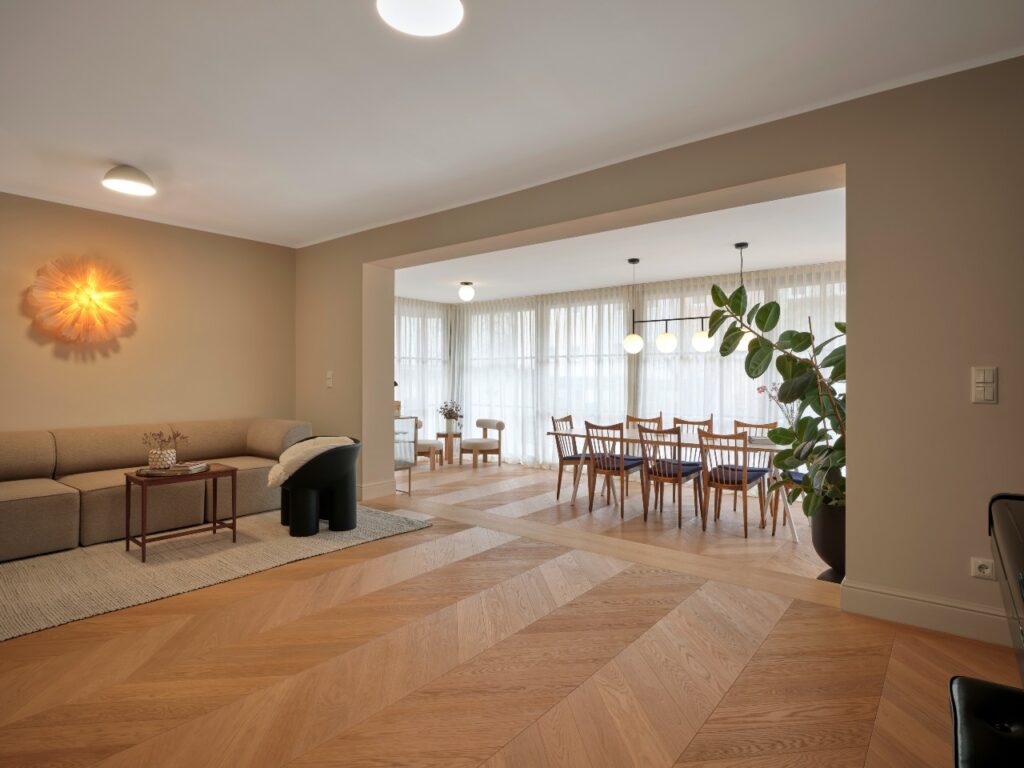
As we navigate through 2024, it’s clear that the world of hardwood flooring is experiencing a dynamic blend of tradition and innovation. From the resurgence of classic patterns like herringbone and chevron to the integration of cutting-edge smart technologies, hardwood floors are adapting to meet the diverse needs and preferences of modern homeowners.
The trends we’ve explored reflect a growing desire for sustainable, personalized, and multifunctional living spaces. Eco-friendly options and reclaimed wood speak to our increased environmental consciousness, while wide planks and mixed widths offer new ways to express individual style. The shift towards matte finishes and textured surfaces demonstrates a preference for natural, authentic aesthetics that celebrate the inherent beauty of wood.
Remember, while trends can guide your choices, the best hardwood floor for your home is one that resonates with your personal style and meets your practical needs. With the wide array of options available, it’s an exciting time to consider hardwood flooring for your space.
